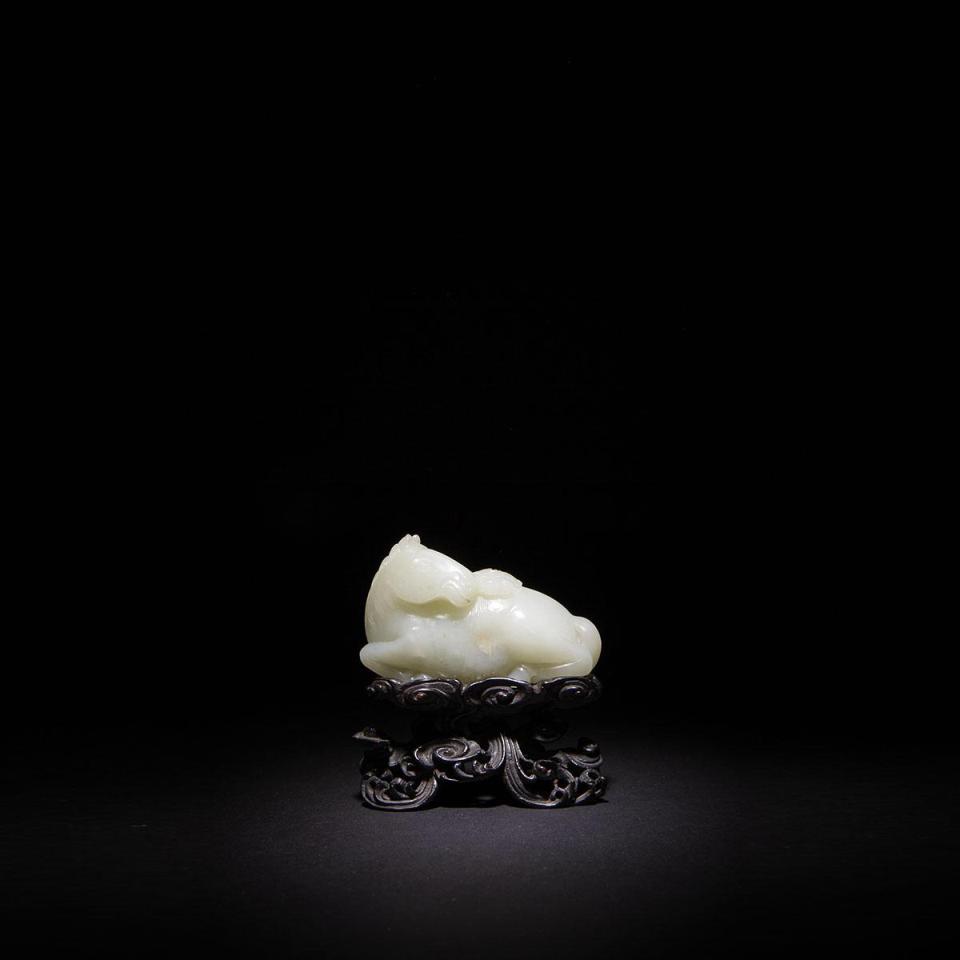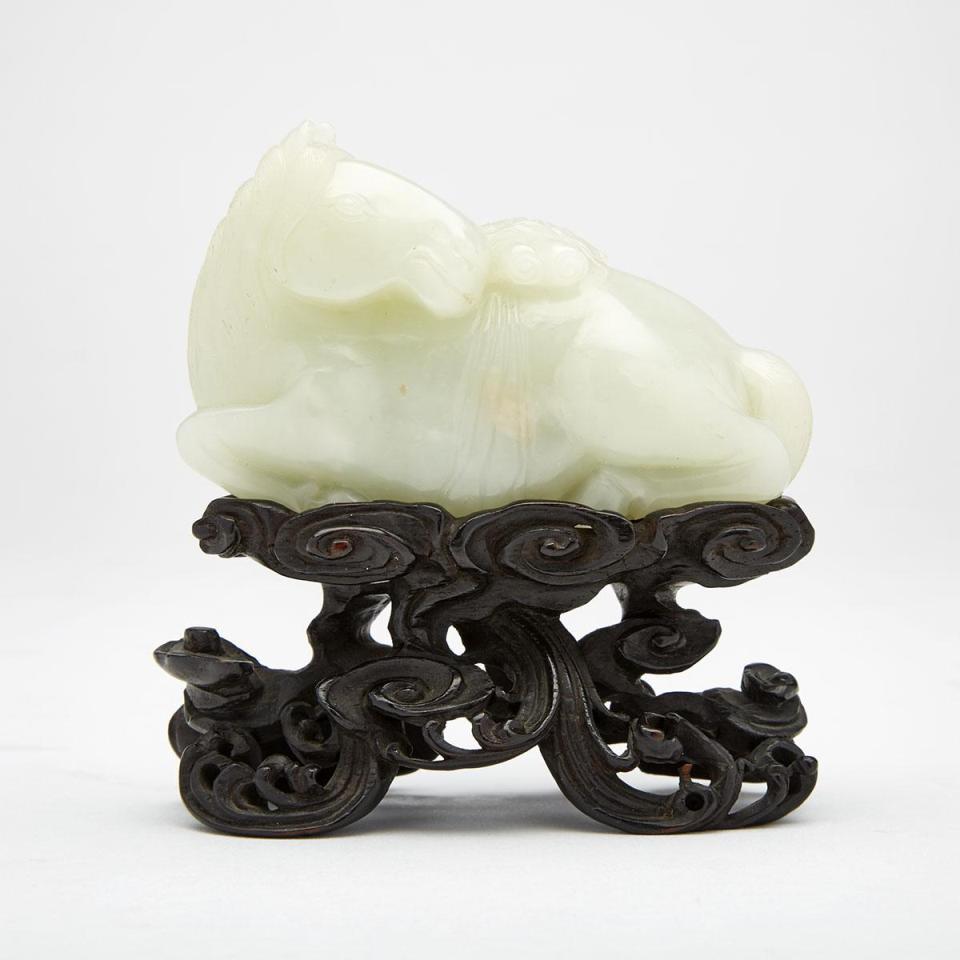Lot 337
A Celadon White Jade Horse with Zitan Rosewood Reticulated Stand, Qianlong Period, 18th Century

Lot 337 Details
A Celadon White Jade Horse with Zitan Rosewood Reticulated Stand, Qianlong Period, 18th Century
清乾隆 青白玉海馬負書擺件 海波紋紫檀座
A finely carved recumbent horse shown with its head turned sharply over the left shoulder and four legs with hooves tucked under the belly, almond-shaped eyes, nostril and mouth softly moulded with ears standing upright, fine striations carved for both the mane and the tail, a package of two scrolls bound tightly with flowing ribbons and strapped around the middle torso, with reticulated rosewood stand of rolling waves
(without stand) length 3.5" — 8.9 cm.
Estimate $20,000-$30,000
Additional Images

Provenance:
From the collection of P. A. B. Widener, and thence by descent (according to dealer’s card)
From an important private collection, Canada
美國著名企業家 P. A. B. 懷德納珍藏
Peter Arrell Brown Widener
November 13, 1834 – November 6, 1915
Born in Pennsylvania in 1834, P.A.B. Widener was an American art collector, prominent businessman, philanthropist and head of the Widener family of Philadelphia. He began his career as a merchant who supplied meat to the Union Army during the Civil War, rising to prominence and eventually becoming Philadelphia City Treasurer in 1873. A decade later, Widener had achieved great success through his investments in trolley cars and public transit systems, acting as a founding partner of Philadelphia Traction Company, which later expanded to other major American cities. Widener translated this wealth into further successes, becoming an original organizer of U.S. Steel and the American Tobacco Company, as well as acquiring substantial holdings in Standard Oil.
However, his interests were not limited to business. Throughout his life, P.A.B. Widener amassed an impressive and discerning collection of art, including paintings by Rembrandt, Édouard Manet and Auguste Renoir, and many pieces of fine Chinese porcelain, which are included in the permanent collections of several important galleries. He also commissioned the construction of two noteworthy dwellings, the first of which was an ornate mansion by architect Willis G. Hale at the northwest corner of Broad Street and Girard Avenue in Philadelphia. He lived at this property for thirteen years, eventually donating it to the Free Library of Philadelphia as a memorial to his late wife, Hannah. In 1900, he completed Lynnewood Hall in Elkins Park, Pennsylvania. Designed by Horace Trumbauer, the impressive 110-room Georgian-style mansion was conceived of as a gallery space for what Fortune Magazine called "the finest private collection of past art to be found in the U.S." Lynnewood Hall remained Widener’s home until his death in 1915.
Peter and Hannah Widener had three sons – Harry (1859-1874), Joseph Early (1871-1943), and George Dunton (1861-1912). George, along with his son, the businessman and bibliophile Harry Elkins Widener, perished on the RMS Titanic. The Widener Library at Harvard University was donated by Harry Elkin’s mother, Eleanor Elkins Widener, in memory of her son. Joseph Early Widener shared his father’s passion for art, and continued to build the elder Widener’s collection at Lynnewood Hall, adding works by Vermeer, Raphael, and Frans Hals amongst others. Notably, Joseph Early was also a founding benefactor of the National Gallery of Art in Washington, D.C. Comprised of more than two-thousand sculptures, paintings, decorative and porcelain works, the Widener Collection was announced by U.S. President Franklin D. Roosevelt in 1939, and was first displayed in 1942. Joseph Widener’s 1921 portrait by Augustus John hangs in the National Gallery of Art.
The Widener family has a renowned and significant history, with notable contributions to the growth of American infrastructure. P.A.B. Widener is also considered to be one of the wealthiest 100 Americans, having amassed a sizeable fortune through his varied and innovative entrepreneurial endeavours.
Note:
This rare example of a celadon horse carving is notable for its size as a piece of Qianlong celadon white jade. The colour retains a light green complexion in an overall white base. Each of the four legs are naturalistically rendered, gently sunken into the horse’s flank and belly, while still featuring prominent haunches and shoulders. The inclusion of a set of scrolls complete with flowing ribbon binding demonstrates the artist’s unrestricted agency in carving large amounts of quality jade from the piece. In addition, the piece has survived with an old rosewood stand, crafted specifically to snugly support the horse’s recumbent form as rolling waves swell from a narrow waist.
This type of jade horse carving was popularized beginning in the Song dynasty, standardized with four legs folded underneath the body and the head directly rear-facing. Two Song dynasty examples of this form are published in Chinese Jade Animals 《中國肖生玉雕》1997, Hong Kong Museum of Art 《香港藝術館》 plates 125 and 127, pages 144-147. However, the addition of scrolls strapped to the back is less commonly found.
The scrolls may represent the first Buddhist sutras to enter China, a narrative taking place in the Han dynasty. In compliance with Emperor Han Mingdi’s 漢明帝 vision of the Buddha, Buddhist monks were escorted from India into China, along with a white horse upon which the holy scriptures were mounted. The emperor subsequently commissioned the construction of the White Horse Temple 白馬寺 in the capital of Luoyang, which still stands today. However, together with the rosewood stand of swirling waves, this piece may be a reference to an older narrative revolving around a legendary horse sent by sea as a Mandate from Heaven. Carrying divine manuscripts and travelling via maritime route, the horse was sent to deliver a heavenly mandate to the emperor for a fair and virtuous rule, a testament to the emperor’s direct connection to heaven and unquestionable legitimacy of power. Another example of a jade horse carved complete with books and waves can be found in the Beijing Palace Museum 1995 publication on jade 《玉器(下)》 plate 90, page 110.
The scroll binding is crafted using a classical Chinese style of flowing ribbons. The mane is carved with fine, uniform striations neatly separated into bunches with a gentle ridge to delineate the crest of the neck. The tail is carved in a similar fashion, tucked neatly underneath the horse’s rear. Finer hairs line the bottom of the eye as bottom lashes.
Another example of a celadon white jade recumbent horse was sold at Sotheby’s Hong Kong, October 8, 2010, lot 2798.








